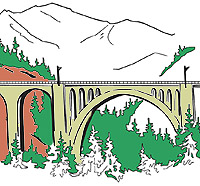Willow Hamlet is a modest Plantation now 60 years old, that was originally planted to serve as a base for mining operations in the Scarlet Mountains, which are known to be rich in Iron and Silver. No significant prospecting or mining has been conducted in living memory, which is to say 30 years.
The hamlet is situated across the watered gorge known as The Scarlet River, from the foot of Old Knob, the lowest, baldest and most southern of the Scarlet Mountains. The west side of the river is not fordable north of the heavy rope bridge that sways across the River, 40 feet above the swift cold waters and the jagged slabs of red slate and sandstone. Neither is the way passable on foot north of Willow Hamlet on the west side of the gorge.
South of the Hamlet, 100 paces are The Falls, a thirty foot drop in the gash of a river bed, which takes it down into swampy meadows favored by Moose and less ordinary creatures. This expanse spreads out to the south, east and west, as the river threads its lower way to the sea through this maze of pools, sinkholes, seeps and gullies.
Opposite the hamlet, across the inconvenient and dangerous gorge, threads the Goatherd track among the low grassy hills that attend Old Knob at its feet. Old Knob itself is bald above 500 feet, towering as it does to 1500 feet, below this chalky pile of red striated walls and rusty black stone buttresses, the waist of the mountain is covered in stunted oaks and maple.
Away south and west the land opens up to even pasture dotted with low hills of a hundred feet of less, clothed in spreading oak and bunched maple about their feet and topped with pitch pine and fir.
To the east of Willow Hamlet, its soaring boughs looming far and above the mere 15 foot high stockade wall, is a great old cedar forest. This dark green expanse rises to east and northeast with the increase in elevation. These increasingly massive trees, some with trunks 20 feet thick, march like sentinels up into the Scarlet Mountain, red cuts of stony mountain face visible among the misty greenery in the rising distance. This is known as Hide Forest.
To the north of Willow Hamlet, as the rope bridge is crossed on wide cedar planks, the wayfarer can see whence the small Plantation got its name. For a league along the river, between the red stone mountains to the west and the soaring green cedars to the east, runs a half mile wide expanse of weeping willows, seemingly sheltered on one hand from the red rocks and on the other under their gigantic cousin trees. A narrow road wends its way between the wall of great cedar trunks and the willows up towards a curiously rounded set of ochre-tainted hills.
An easy musket shot, being 50 paces, above the bridge, in part overhanging the scarlet gorge is a block house with firing ports, a sturdy garrison house for refuge in battle and command of the bridge. A sentry with musket ever stands on the widow walk upon the roof, between a Silver leaf on Green banner either fluttering or hanging limp, and a bell, what actually appears to be a ship’s bell far from home.
Beneath the front porch of this important house, a small swift creek passes under a footman’s rounded bridge, narrow enough to admit only one broad man or horse and being made of a five foot ramp, a five foot top span and a five foot ramp, a bridge built to be defended by a single man if necessary. This bridge debouched onto a beaten track—the continuation of the North Road—north between the Block House and a great woodshed. The creek splashes out in a little horsetail fall beneath to south west corner of the block house.
On the south side of creek, known simply as The Creek, the road has been widened and improved with red slate flags that take the wayfarer past the jail and gated slave pen, to the Willow Inn.
The area encircled by the Scarlet Gorge to the west, the creek to the north, and the stockade wall to the east and south, is a mere two acres. The central building, being the inn, a great plank house with kitchen, great hall, cellar, and 14 rooms on the second story, is as large as the other buildings combined, which are described below, all of which are log cabins. Small cabins are 12 by 16, large 16 by 24, all with a red brick fire place and chimney and red slate hearth, firewood lining the outer walls.
From east to west, behind the Inn:
Brewery, were the Creek emerges from the forest around which the stockade wall has been built with an axle for the waterwheel placed there. The brewery is built up against the southeast corner of the inn.
Under the east wall behind the brewery is a maid’s cabin.
Directly behind the Inn is a matron’s cabin.
Between these two cabins laundry is done in casks and hung from poles.
Against the southern wall of the stockade are three cabins:
The largest is the iron smithy and forge, to the east next to the maid’s cabin.
Behind the matron’s cabin is a jеweler’s cabin and silver smith’s cabin.
To the southwest is The Crap Door, where a wooden gate to the crap house outside of the southwest corner is guarded by an unhappy soul.
Against the west wall of the stockade is the Silver Chapel, the shrine of Willow Hamlet Plantation, a cabin topped with a star of beaten silver, which is polished by a slave daily.
Between the west wall, the chapel, the inn and the jail and slave pen, which is the first building to front the bridge from the west track, is an extensive garden, positioned for the best sunlight.
Between the east wall of the inn, the brewery and the waterwheel is a shade garden, kept by the brewer.
North of the Creek, the wall extends 40 feet to the hen house, with the chicken coop preventing the birds from fouling the creek water.
Where the wall terminates one may draw a straight east to west line to the Block House and footman’s bridge along the open south face of the wood shed. The track north leaves between the block house and shed.
The woodshed is 18 feet high, built with cedar top beams between four massive trunks of trees that were cut 18 feet up. Hand holds are notched into these four 8 foot thick trunks, so that each of these stumps serve as lookout towers. The tops of each have been hollowed to chest high, so a man might stand and deliver musket fire or loose arrows.
The wood from the tops of these four woodshed pillars provided planks for the inn 60 years ago when it was the third building after the block house and the shed to be erected. The rest of the wood required to build the great inn was got from the main spans of the three cedar stump houses to the east, between the shed and the line of the stockade.
These structures are called the Ranger Cabins, but are not cabins at all. Rather these are watch towers rendered from standing trunks. These three massive cedar, 60 feet apart, each, one from the wood shed and the other two from each other, the second in line with the stockade and the third outside its geometry, have been hollowed out, floored for a second story and roofed for a watch platform.
While the Hide Forest looms thick and high over the stockade, an entire acre of clear ground is kept scythed down and used to graze the few milk cows and ranger horses, the former belonging to the Inn.
The goat herds bring their flocks across the rope bridge at dusk and make camp outside of the western stockade wall, between it and the Scarlet Gorge above The Falls. The space between the stockade and the gorge, also occupied by the ramshackle crap house, where the goatherds camp, constitutes nearly two acres, denuded of plant growth, overlooking the naked, roaring gorge.
A rocky slope to the south of this, covered in a thick tangle of thorny blackberry, extends below and to the south of the stockade wall, to the southeast corner, where the great cedars shade that end of the slope, choking out anything but moss and ferns.











